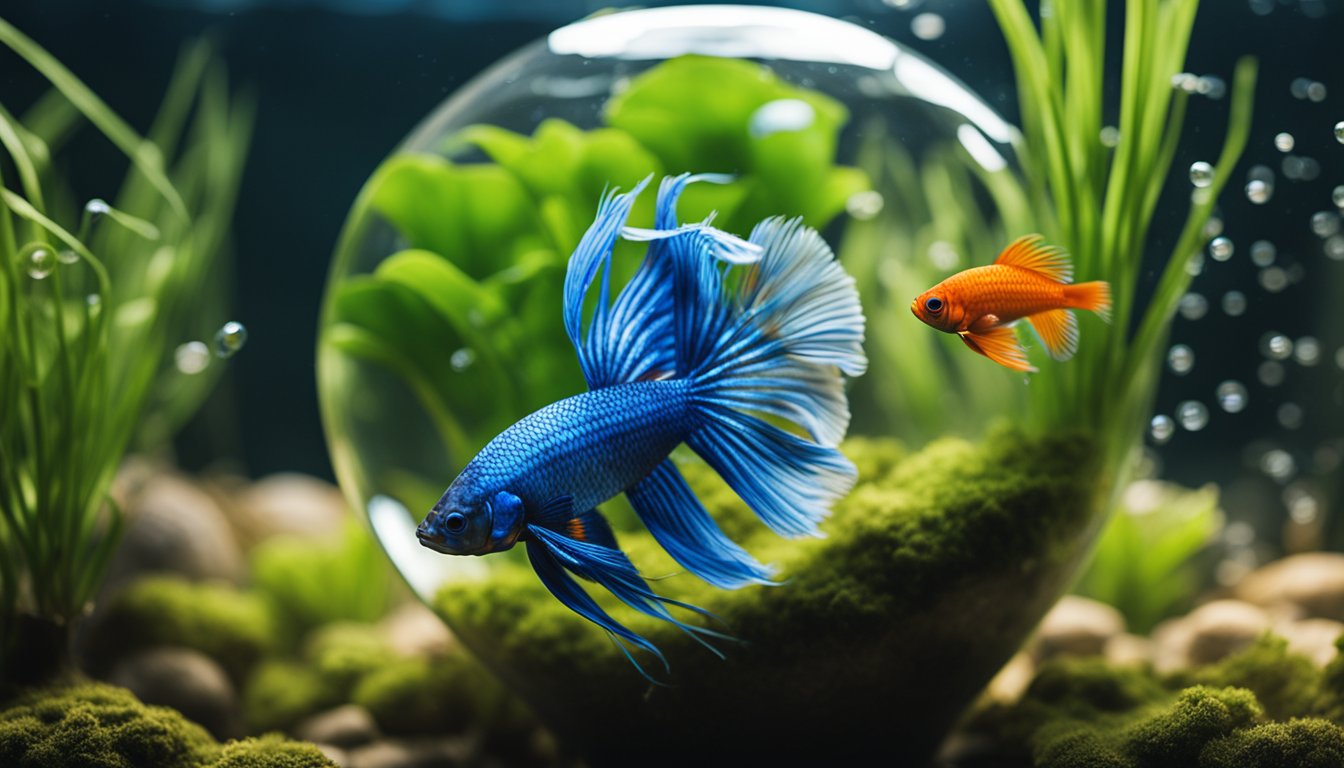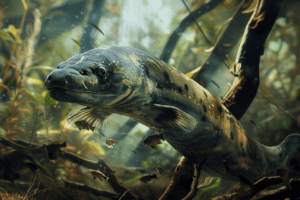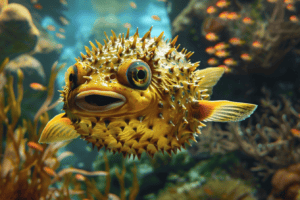Siamese Fighting Fish, also known as Betta fish, are renowned for their flamboyant colors and aggressive behavior.
However, what many people don’t know is that these fish are also skilled architects.
The Bubble Architects: Nest Building by the Siamese Fighting Fish is an article that explores the fascinating world of Betta fish and their unique nesting behavior.

Male Betta fish are responsible for building bubble nests, which serve as a safe haven for their offspring.
These nests are made by blowing bubbles and secreting a special mucus that allows the bubbles to stick together.
The result is a floating raft of bubbles that can support the weight of the eggs and newly hatched fry.
The article delves into the science behind this behavior and the intricate details of how these nests are constructed.
Readers will also learn about the different types of materials that Betta fish use to build their nests, including plant matter and even their own saliva.
The article provides interesting facts and statistics about Betta fish, such as the fact that they can live up to five years in captivity and that there are over 70 different species of Betta fish in the world.
Overall, The Bubble Architects: Nest Building by the Siamese Fighting Fish is an informative and engaging read for anyone interested in the natural world.
The Art of Bubble Nest Building
Architectural Marvels
The Siamese Fighting Fish, also known as Betta fish, are known for their vibrant colors and aggressive behavior.
However, they are also skilled architects who build intricate bubble nests to protect their offspring.
These bubble nests are architectural marvels that can be found in the shallow waters of Southeast Asia.
The male Betta fish uses his mouth to blow bubbles, which he then arranges into a floating nest.
The bubbles are coated with a special mucus that helps them stick together, creating a sturdy structure that can hold the eggs and newly hatched fry.
The bubble nest is not just a functional structure, but also a work of art.
The male Betta fish carefully arranges the bubbles in a circular pattern, creating a beautiful and symmetrical design.
The nest is also designed to be buoyant, so it can float on the surface of the water and protect the eggs from predators.
Bubble Nest Construction Process
The construction of a bubble nest is a complex process that requires skill and patience.
The male Betta fish starts by selecting a suitable location for the nest, usually near a plant or other object that can provide additional support.
Once the location is chosen, the male Betta fish begins to blow bubbles using his mouth.
He blows the bubbles in a circular pattern, creating a base layer for the nest.
He then adds more layers of bubbles, carefully arranging them to create a sturdy and symmetrical structure.
The male Betta fish continues to add bubbles until the nest is complete. He then entices a female Betta fish to lay her eggs in the nest.
Once the eggs are laid, the male Betta fish guards the nest and ensures that the eggs are well-protected.
In conclusion, the bubble nest building process is a fascinating example of animal behavior and architecture.
The male Betta fish’s skill and attention to detail in constructing these nests is truly remarkable.
It is no wonder that these beautiful structures have captured the imagination of people around the world.
Siamese Fighting Fish: Nature’s Builders

Species Overview
Siamese Fighting Fish, also known as Betta fish, are native to Southeast Asia and are popular aquarium pets due to their vibrant colors and unique personalities.
These fish are known for their aggressive behavior towards other fish, but they are also impressive builders.
Male Siamese Fighting Fish are the ones responsible for building bubble nests, which are made of bubbles and saliva.
These nests are used to protect the eggs and newly hatched fry from predators.
The male will continue to tend to the nest until the fry are large enough to fend for themselves.
The Role of Bubble Nests
Bubble nests are essential for the survival of Siamese Fighting Fish offspring.
The nests are built in shallow waters, such as rice paddies or streams, and can range in size from a few bubbles to several inches in diameter.
The male fish will construct the nest by blowing bubbles and then using his saliva to create a sticky substance that holds the bubbles together.
The nest will continue to grow as the male adds more bubbles and saliva to the structure.
The bubbles in the nest serve as a natural filter, keeping the water clean and oxygenated.
The nest also provides a safe haven for the eggs and fry, protecting them from predators and harsh water currents.
In conclusion, Siamese Fighting Fish are not only known for their beauty and aggression, but also for their impressive nest-building abilities.
Bubble nests are a crucial part of the fish’s reproductive process and ensure the survival of their offspring.
Environmental Influences on Nest Design

Water Conditions
The Siamese fighting fish, also known as Betta fish, are known for their unique nest-building behavior.
The male Betta fish creates a bubble nest on the water’s surface to protect their eggs and fry.
The water conditions play a crucial role in the nest-building process.
The male Betta fish builds a bubble nest in calm water with a temperature range of 78-80 degrees Fahrenheit.
The water’s pH level is also essential in nest building. The ideal pH level for Betta fish is between 6.5 and 7.5.
If the pH level is too high or too low, it can affect the bubble nest’s stability.
The male Betta fish uses saliva to create bubbles, and if the pH level is not suitable, the bubbles may not hold together, leading to the nest’s collapse.
Safety and Predation
The Betta fish’s natural habitat is rice paddies, shallow ponds, and slow-moving streams.
These areas are often filled with predators such as birds, snakes, and larger fish.
To protect their offspring, the male Betta fish builds the bubble nest in a location that is hidden from predators.
The nest’s design plays a vital role in protecting the eggs and fry from predators.
The male Betta fish builds a nest that is sturdy enough to hold the eggs and fry but not too bulky to attract predators.
The nest’s location is also crucial, and the male Betta fish chooses a spot that is hidden from predators but has access to oxygen.
In conclusion, the environmental conditions significantly influence the Siamese fighting fish’s nest-building behavior.
The Betta fish’s ability to create a bubble nest that is stable and safe for their offspring is a testament to their adaptability and survival skills.
Frequently Asked Questions

How do Siamese fighting fish create their bubble nests?
Siamese fighting fish, also known as Betta fish, create their bubble nests by using bubbles of saliva.
The male Betta fish will blow bubbles at the surface of the water, which will then stick together to form a nest.
The male Betta fish will continue to add bubbles to the nest until it is large enough to hold the eggs that the female Betta fish will lay.
Can a male Betta fish build a bubble nest without a female present?
Yes, a male Betta fish can build a bubble nest without a female present.
In fact, male Betta fish will often build bubble nests as a way to attract a female Betta fish to mate with.
However, without a female Betta fish present, the nest will not be used to hold any eggs.
What specific items do Betta fish require in their tanks to assist with bubble nest construction?
Betta fish require clean water and a suitable environment to build their bubble nests.
This includes a tank with a smooth surface for the bubbles to stick to, as well as plants or other objects for the male Betta fish to anchor the nest to.
What does it signify about a Betta fish’s behavior or health when it constructs a bubble nest?
When a Betta fish constructs a bubble nest, it signifies that the fish is healthy and ready to mate.
It is a natural behavior for male Betta fish to build bubble nests, and it is a sign that they are in good condition.
Is it advisable to leave the bubble nest in the aquarium, or should it be removed?
It is advisable to leave the bubble nest in the aquarium, as removing it may disturb the male Betta fish and cause him to stop building the nest.
Additionally, the nest may be used in the future if a female Betta fish is introduced to the tank.
What is the typical duration for a male Betta to complete its bubble nest?
The duration for a male Betta to complete its bubble nest can vary, but it typically takes a few hours to a few days.
The male Betta fish will continue to add bubbles to the nest until it is large enough to hold the eggs that the female Betta fish will lay.









